Creating a Zen living room is about more than just aesthetics; it's about curating a sanctuary of peace and tranquility within your own home. This design philosophy emphasizes harmony, balance, and a deep connection to the natural world. By focusing on simplicity, uncluttered spaces, and mindful decor choices, you can transform your main living area into a serene retreat from the stresses of daily life. The core principles involve using natural materials, a muted color palette, and maximizing light to foster an atmosphere of calm and relaxation, allowing for quiet contemplation and rejuvenation.
1. Incorporate Low-Profile Furniture
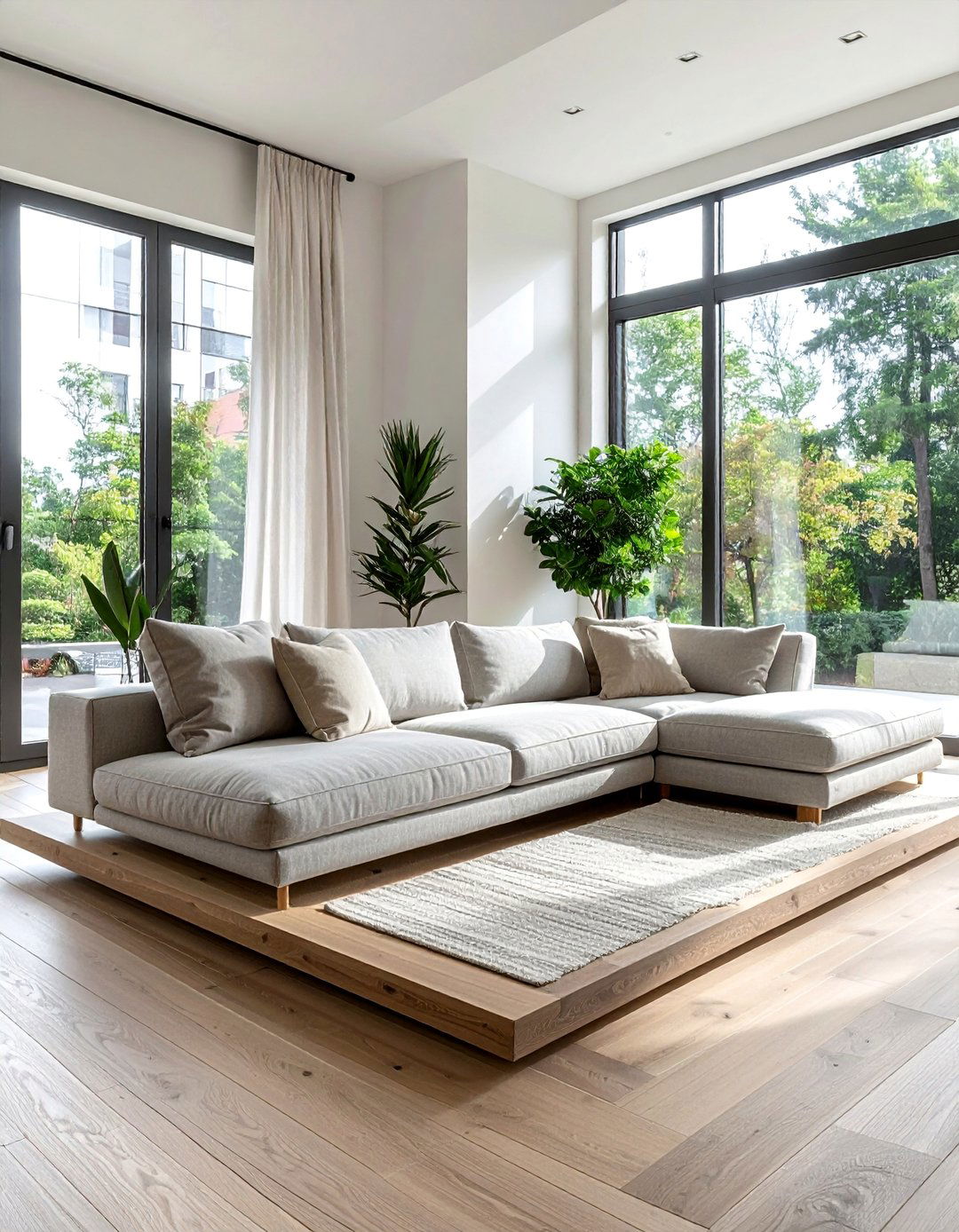
A fundamental aspect of Zen design is fostering a closer connection to the earth, which can be achieved through low-profile furniture. Opt for sofas, coffee tables, and media consoles that sit low to the ground. This style of furnishing not only creates the illusion of higher ceilings and a more open, airy space but also encourages a grounded, centered feeling. Choose pieces made from natural wood with clean, simple lines and minimal ornamentation. This approach reduces visual clutter and promotes a sense of stability and calm. A low-slung sectional or a simple wooden platform coffee table can serve as the perfect anchor for your peaceful Zen living room.
2. Adopt an Earth-Tone Color Palette
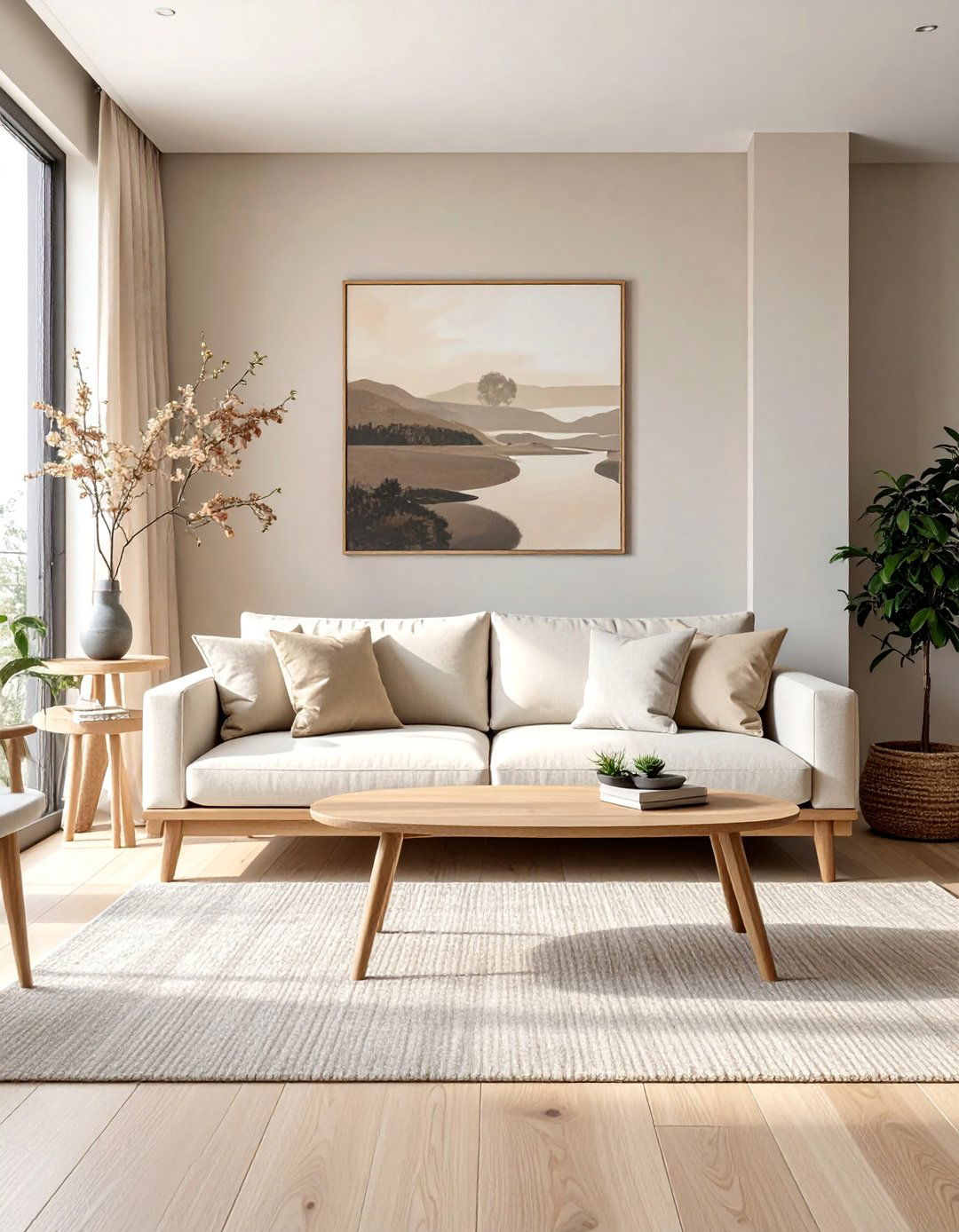
The color scheme in a Zen living room should be soft, natural, and soothing to the eye. An earth-tone palette is essential for creating this tranquil atmosphere. Think in shades of beige, cream, soft grays, gentle whites, and muted browns. These colors mimic the serene hues found in nature, promoting relaxation and mindfulness. Avoid loud, jarring colors that can disrupt the calm. To add subtle depth, you can layer different shades of the same color family. For instance, combine a light beige wall with a slightly darker greige sofa and cream-colored cushions. This monochromatic approach enhances the sense of harmony and understated elegance in the space.
3. Utilize Natural Materials and Textures
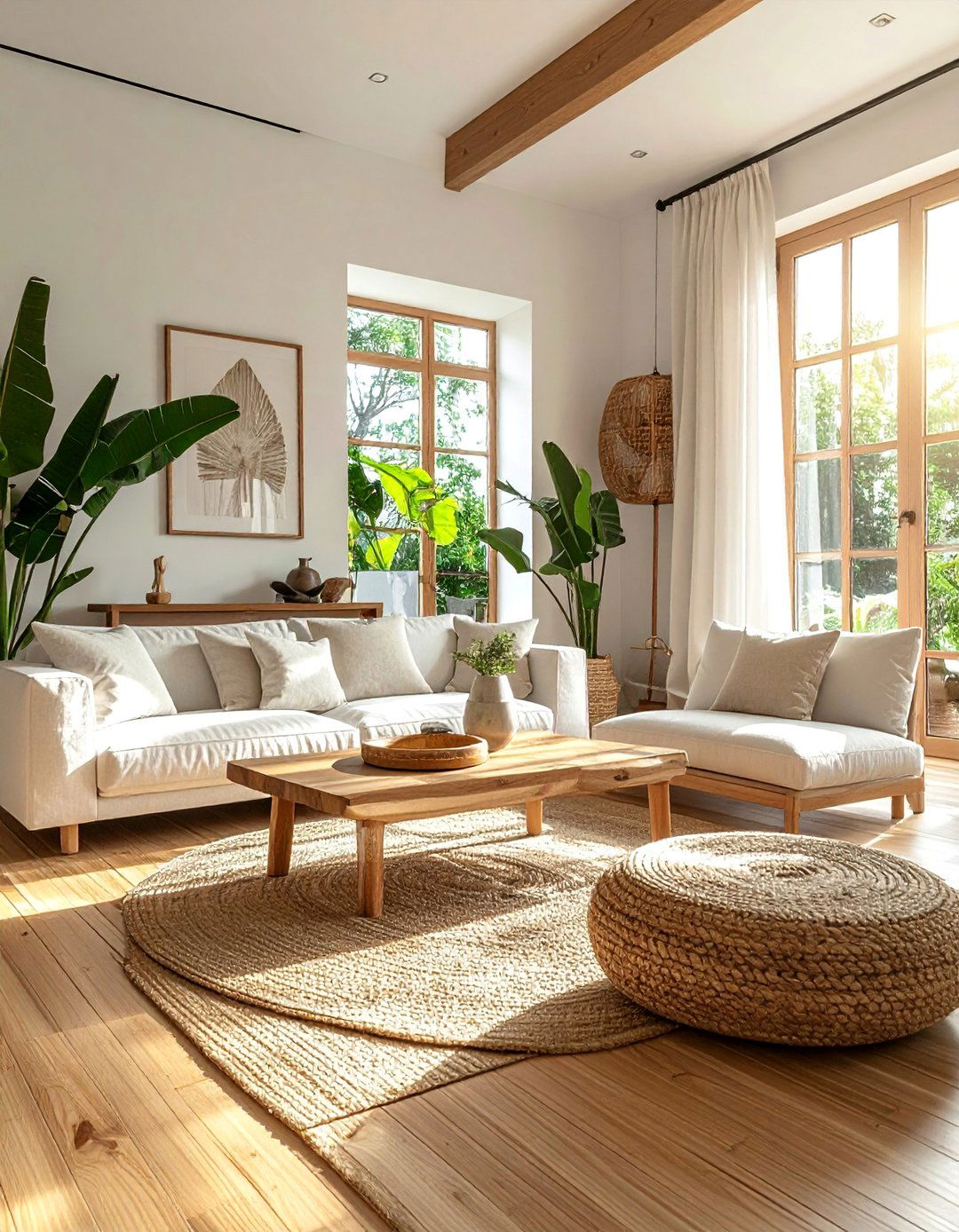
Bringing the outdoors in is a cornerstone of Zen philosophy, and using natural materials is the most direct way to achieve this. Incorporate elements like wood, bamboo, stone, and natural fibers throughout your living room. Consider a solid oak coffee table, bamboo flooring, or a feature wall with slate stone tiles. For textiles, choose fabrics like linen, cotton, and wool for curtains, upholstery, and throw pillows. These materials not only add warmth and texture but also engage the senses, creating a richer, more organic environment. The subtle imperfections and unique grains in these natural elements celebrate the wabi-sabi principle of finding beauty in imperfection, further enhancing the room’s peaceful character.
4. Maximize Natural Light with Sheer Curtains
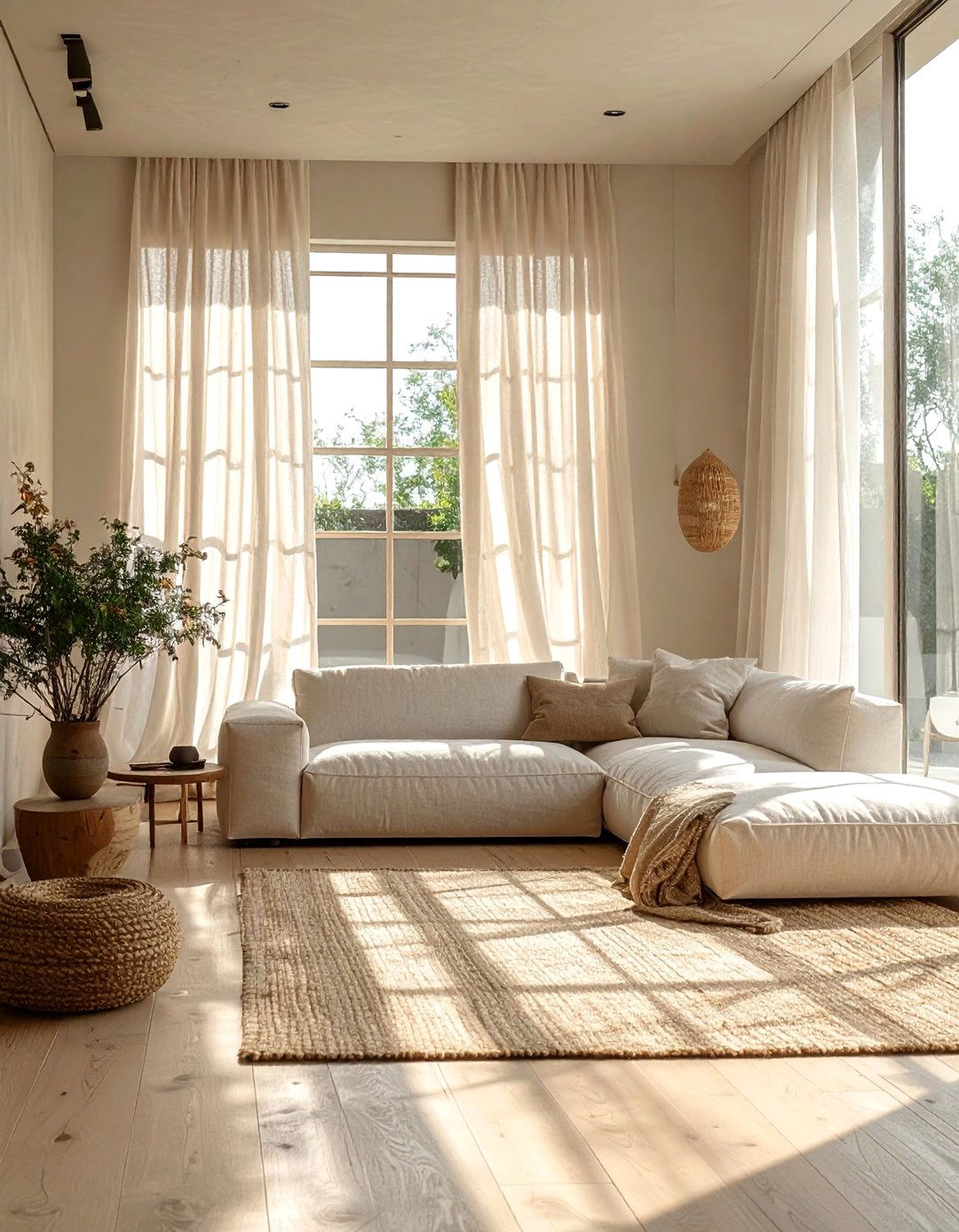
Natural light is a powerful element for creating a positive and serene environment. To maximize its impact in your Zen living room, keep window treatments minimal and light. Heavy, dark drapes can block energy and make a room feel closed off. Instead, opt for sheer, lightweight curtains made from natural fabrics like linen or cotton in a neutral color. These allow sunlight to filter through gently, illuminating the space while still providing a degree of privacy. Another excellent option is to use bamboo blinds or simple rice paper shades, which diffuse light beautifully and add an authentic touch of Japanese-inspired design, filling the room with a soft, warm glow.
5. Declutter with Mindful Storage Solutions

A clutter-free environment is non-negotiable for a true Zen living room, as physical clutter often translates to mental clutter. The key is to be intentional about what you keep and to have a designated place for everything. Invest in mindful storage solutions that are both functional and aesthetically pleasing. Look for minimalist cabinets, credenzas, or sideboards made of natural wood with clean lines and no visible hardware. Woven baskets made from seagrass or rattan are perfect for stowing away blankets or magazines. The goal is to keep surfaces clear and maintain an open, uncluttered flow, allowing energy—and your mind—to move freely throughout the space.
6. Introduce Biophilic Design with Indoor Plants
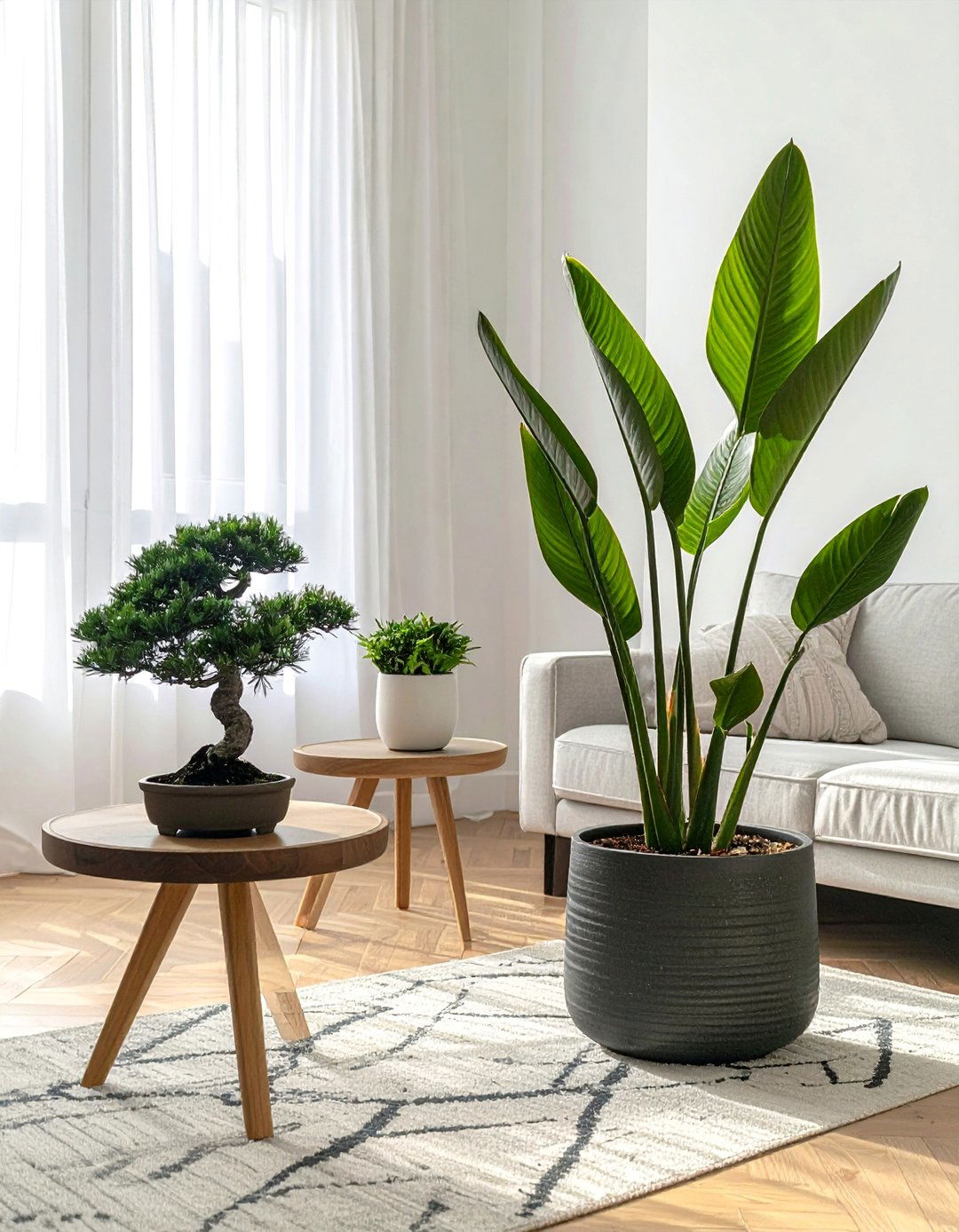
Biophilic design, the practice of connecting people with nature, is integral to a Zen aesthetic. Introducing indoor plants is an easy and effective way to bring life, freshness, and a calming natural element into your living room. Choose plants known for their air-purifying qualities and simple, elegant forms, such as a snake plant, bonsai tree, bamboo stalks in a simple vase, or a fiddle leaf fig. Position them thoughtfully to create focal points without overwhelming the space. The act of caring for plants can also be a meditative practice, reinforcing the room’s purpose as a place for mindfulness and connection to the natural world.
7. Integrate Shoji Screen Room Dividers
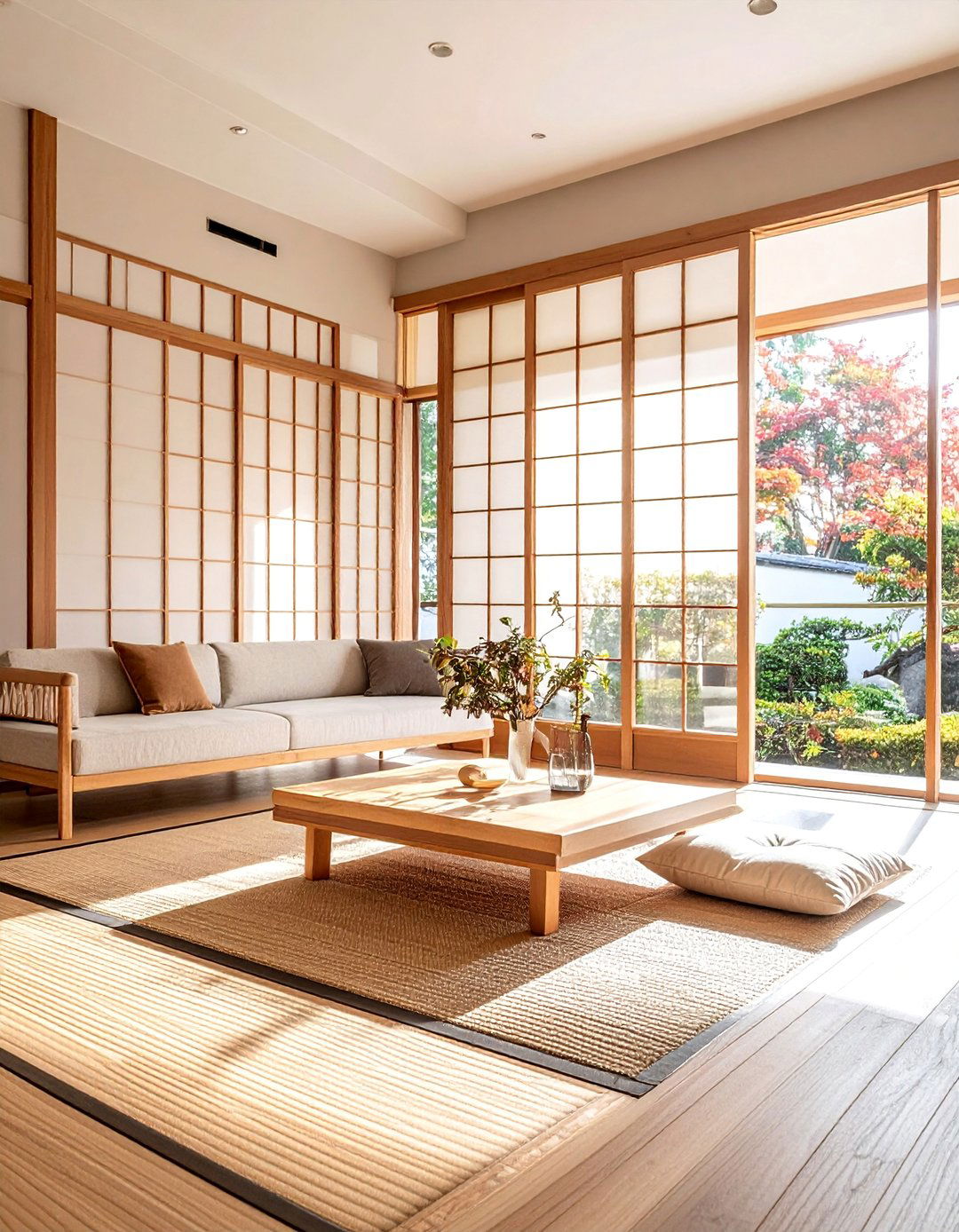
For an authentic touch of Japanese design that also serves a practical purpose, consider integrating Shoji screen dividers. These traditional screens, made from translucent rice paper set in a wooden lattice frame, are perfect for partitioning a larger living area or creating a sense of privacy without blocking light. They diffuse light beautifully, casting a soft, ethereal glow that enhances the room’s tranquil ambiance. Shoji screens can be used as freestanding dividers, sliding doors for a closet, or even as unique window coverings. Their lightweight construction and minimalist design add a layer of architectural interest while maintaining the open and airy feel essential to a Zen space.
8. Create a Focal Point with a Single Statement Artwork
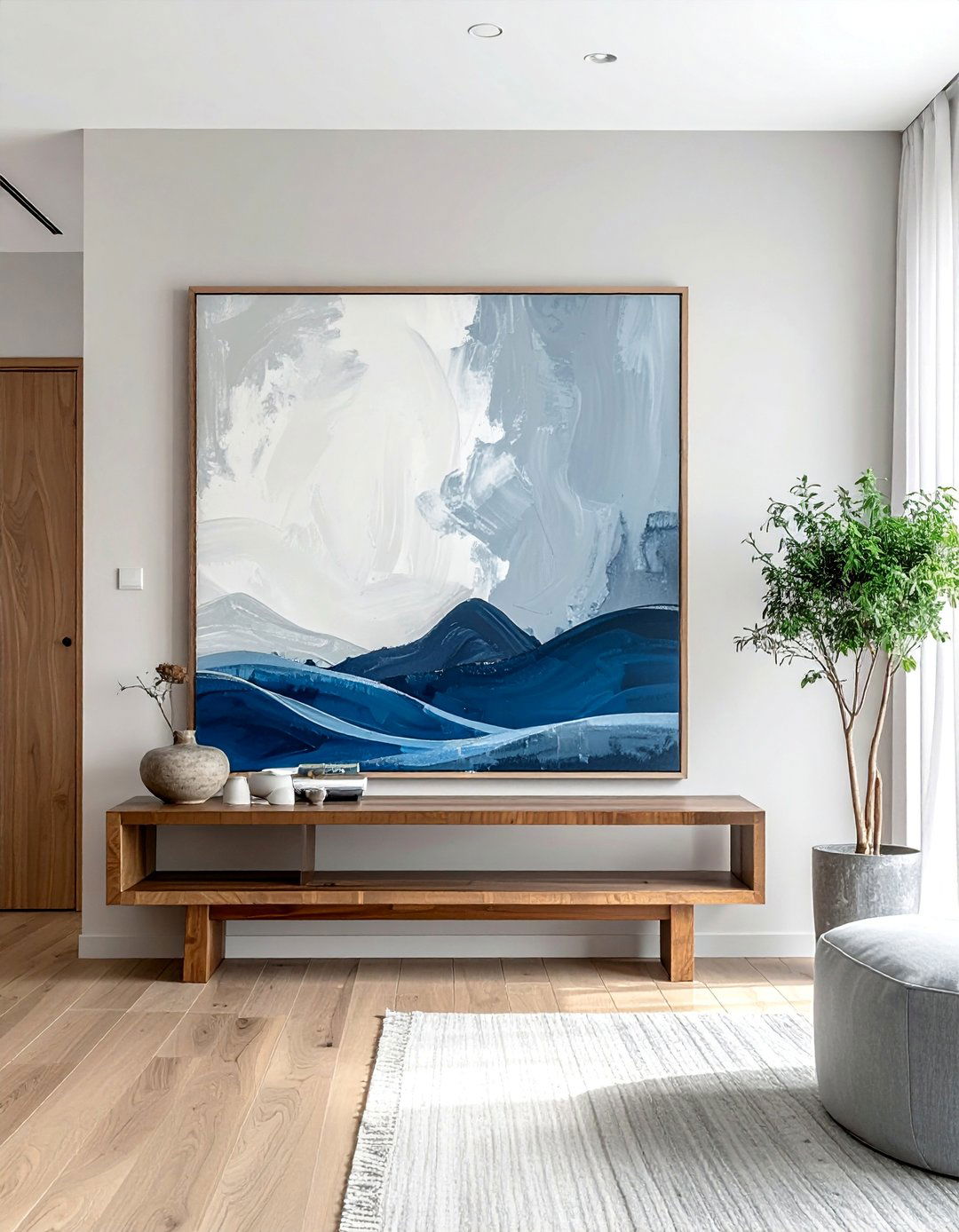
In a Zen living room, less is truly more. Instead of filling walls with multiple pieces of art, create a single, powerful focal point. Choose one large piece of artwork that evokes a sense of calm and contemplation. This could be a minimalist abstract painting with soft, blended colors, a large-scale photograph of a serene landscape, or a piece of Japanese calligraphy (shodo). The key is to select something that resonates with you personally and contributes to the room's peaceful atmosphere. Placing this single statement piece on a prominent wall draws the eye and encourages a moment of quiet reflection, preventing visual overstimulation.
9. Layer Soft, Ambient Lighting
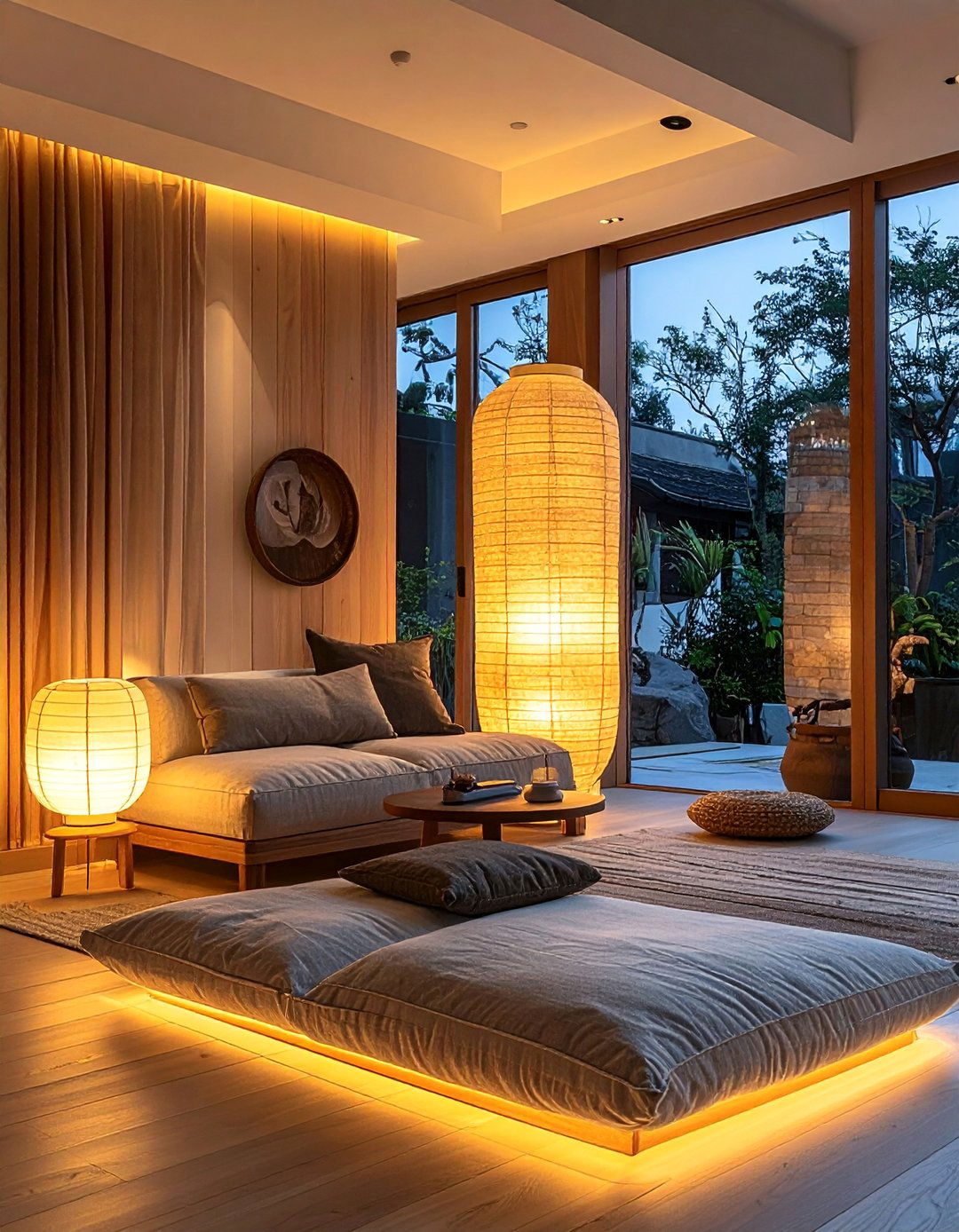
Lighting plays a crucial role in setting the mood of a room. For a Zen living room, the goal is to create a soft, warm, and inviting glow rather than harsh, direct light. Layering different light sources is the best way to achieve this. Start with an overhead fixture that has a dimmer switch, allowing you to control the intensity. Supplement this with ambient lighting from floor lamps and table lamps with simple, natural-looking shades made from paper, linen, or wood. Consider adding accent lighting to highlight a plant or a piece of art. Avoid cool, blue-toned bulbs and opt for warm white light to mimic the gentle radiance of candlelight or sunset.
10. Incorporate a Small Indoor Water Feature

The sound of gently trickling water is universally calming and can instantly enhance the tranquil atmosphere of your Zen living room. Incorporating a small, tabletop water feature is a simple yet highly effective way to introduce this soothing element. Choose a fountain made from natural materials like stone, ceramic, or bamboo to align with the room's aesthetic. The subtle, continuous sound helps to mask distracting background noises and promotes a meditative state of mind. Place it on a side table or a minimalist console where its calming presence can be both seen and heard, transforming your living room into a true sensory sanctuary.
11. Use Floor Cushions for Grounded Seating
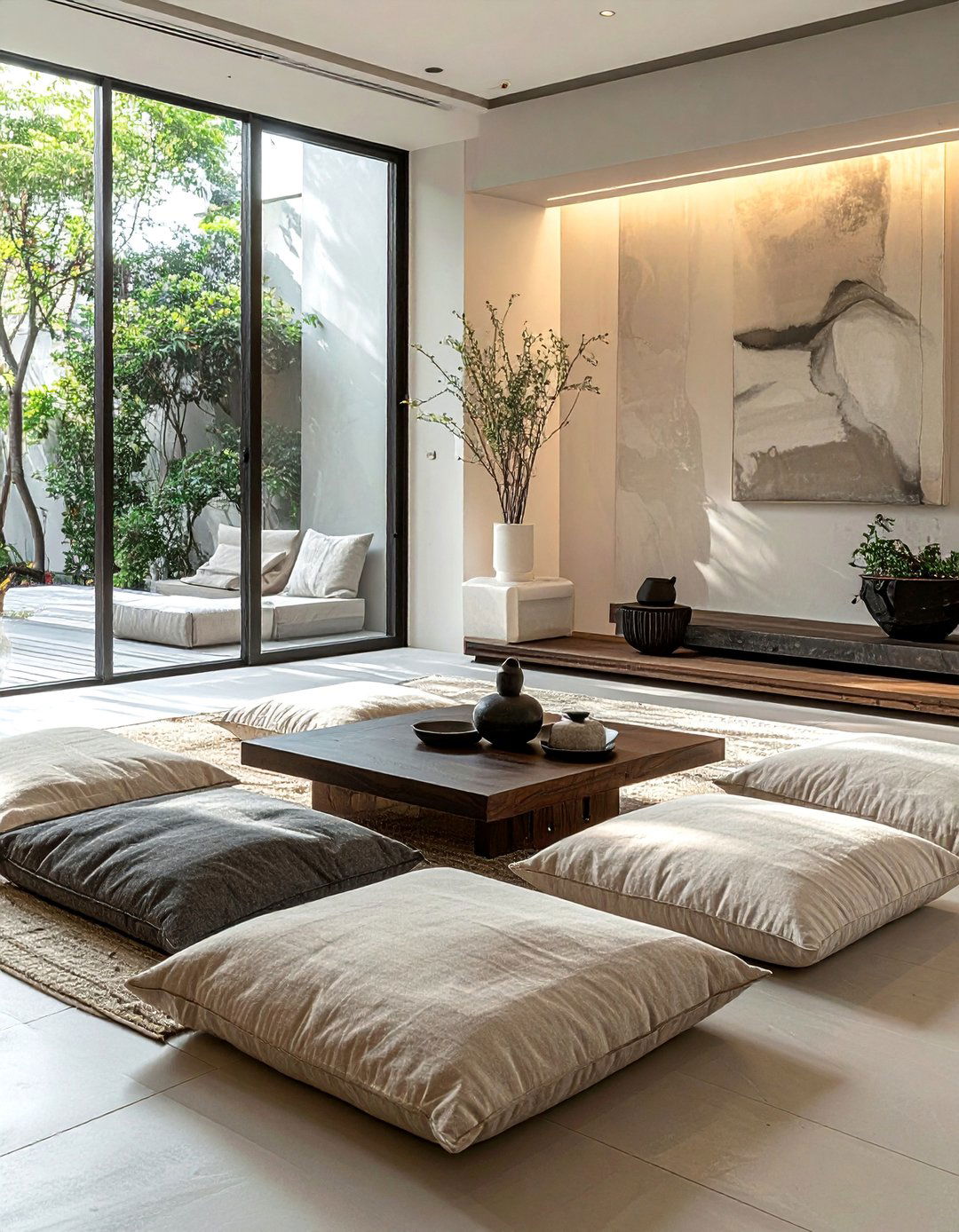
To further emphasize a connection to the earth and introduce flexible, informal seating, incorporate floor cushions. Known as zabuton in Japanese culture, these cushions encourage a more mindful and grounded posture. They are perfect for meditation, quiet reading, or creating a cozy conversation nook around a low coffee table. Choose cushions made from natural fabrics like cotton or linen in solid, earthy tones that complement your overall color palette. Stacking a few cushions in a corner when not in use adds a soft, textural element to the decor without creating clutter. This simple addition makes the space feel more inviting and adaptable.
12. Lay Down a Natural Fiber Rug

A rug can anchor a living room's design while adding warmth and texture underfoot. For a Zen-inspired space, choose a rug made from natural fibers. Materials like jute, sisal, seagrass, or wool are excellent choices as they bring an organic, earthy element to the floor. Opt for a rug in a neutral, solid color or one with a very subtle, simple pattern to avoid creating visual noise. The texture of these natural fibers feels pleasant and grounding, especially when walking barefoot. A large area rug will define the main seating area, unifying the furniture and contributing to the overall sense of harmony and cohesion in the room.
13. Maintain Asymmetrical Balance
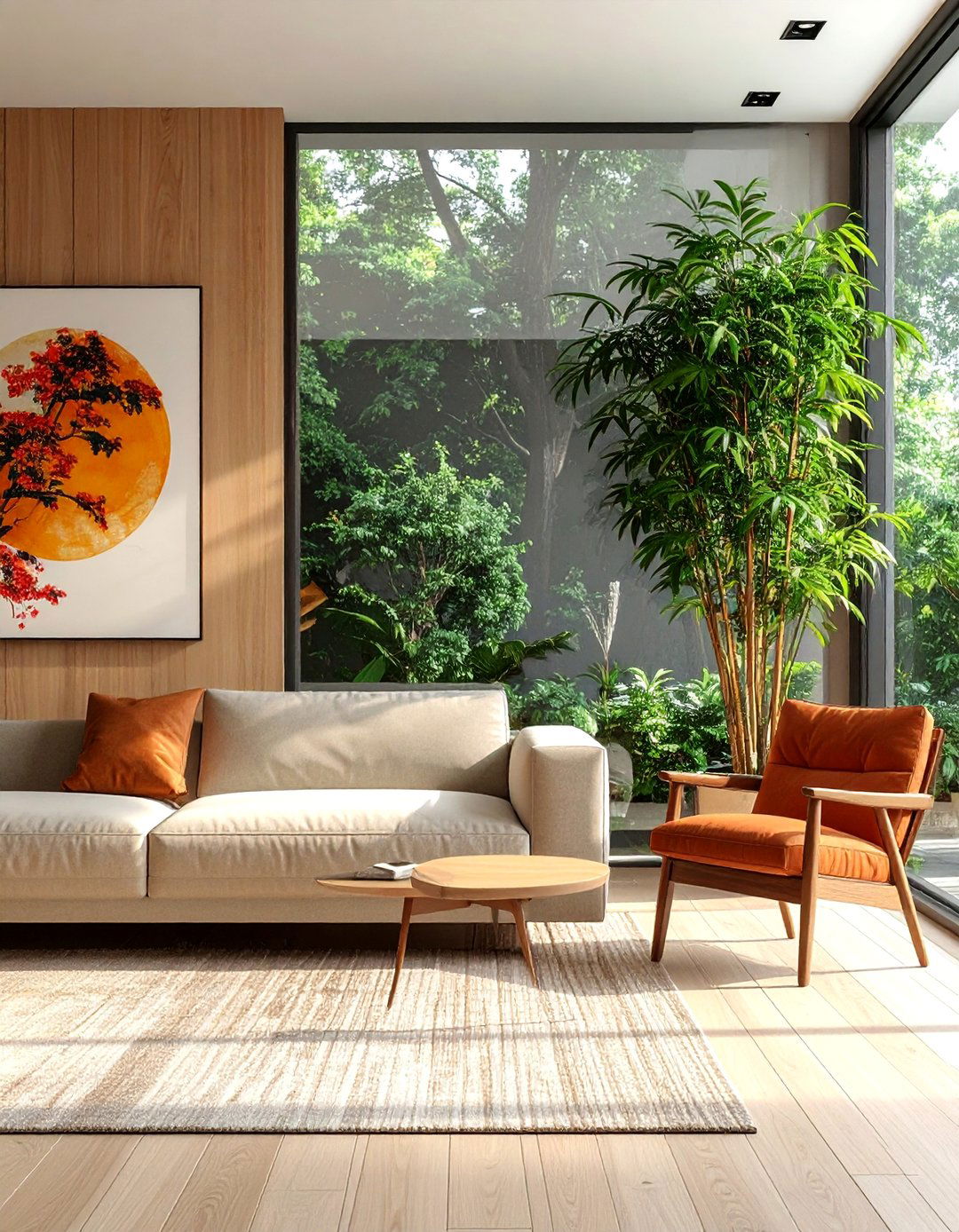
Zen design often draws from the wabi-sabi principle, which finds beauty in imperfection and asymmetry. Instead of arranging furniture and decor in a perfectly symmetrical layout, strive for asymmetrical balance. This creates a more natural, dynamic, and interesting composition. For example, you might balance a large sofa on one side of the room with two smaller armchairs on the other, rather than placing identical sofas opposite each other. Similarly, on a mantel or console table, arrange a group of three objects of varying heights instead of a symmetrical pair. This approach feels less rigid and more organic, contributing to a relaxed and harmonious flow.
14. Select Furniture with Organic Shapes
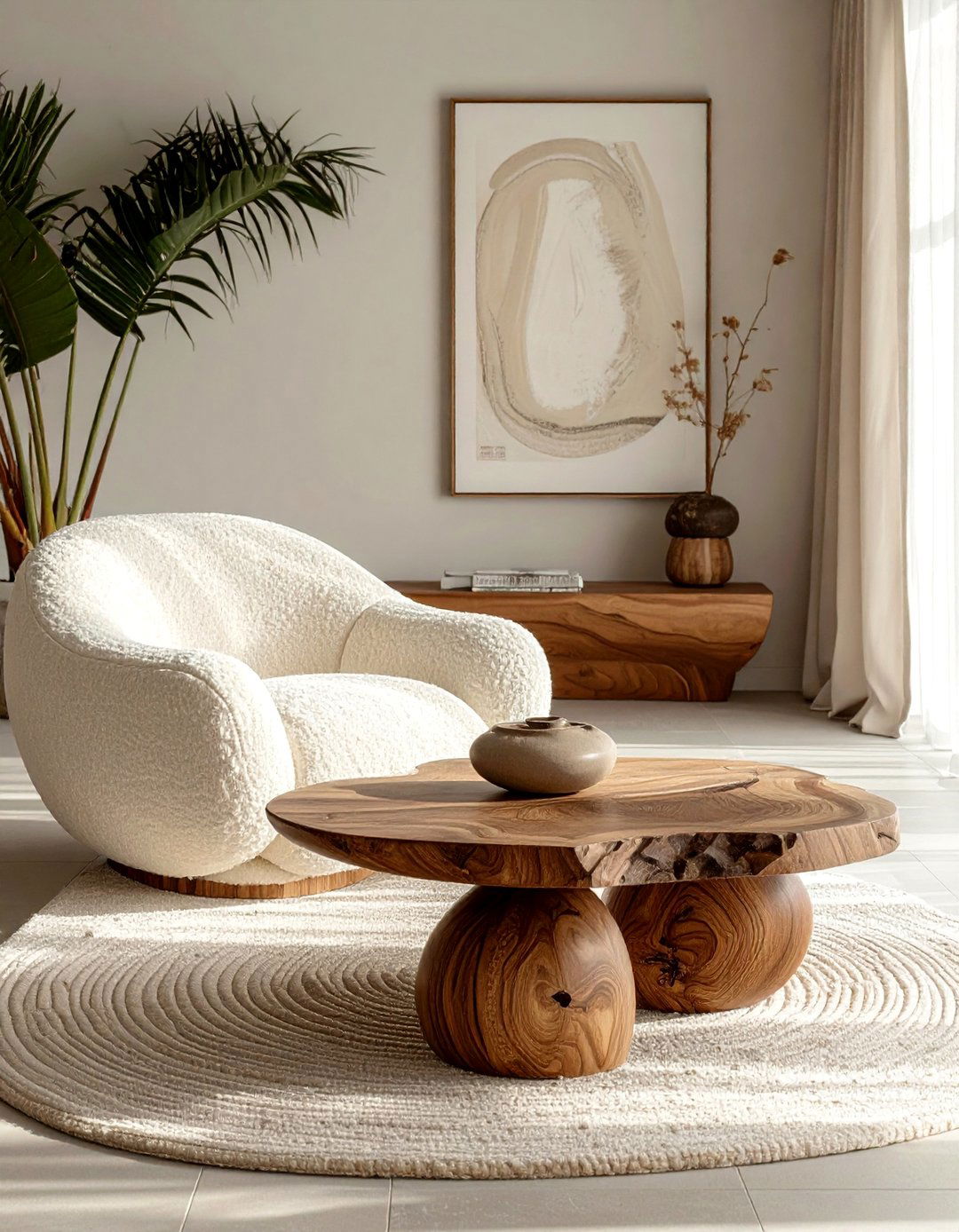
While clean, straight lines are a hallmark of minimalist design, incorporating furniture with soft, organic shapes can add a gentle, natural flow to a Zen living room. Look for a coffee table with a rounded or irregular pebble-like shape, or an armchair with soft, curved lines. These forms mimic the shapes found in nature, breaking up the rigidity of a purely linear design scheme. A round pouf or a curved floor lamp can also introduce this subtle softness. These organic shapes contribute to the room’s calming energy by creating a visual landscape that is gentle on the eyes and promotes a feeling of ease and comfort.
15. Simplify Window Treatments with Bamboo Blinds
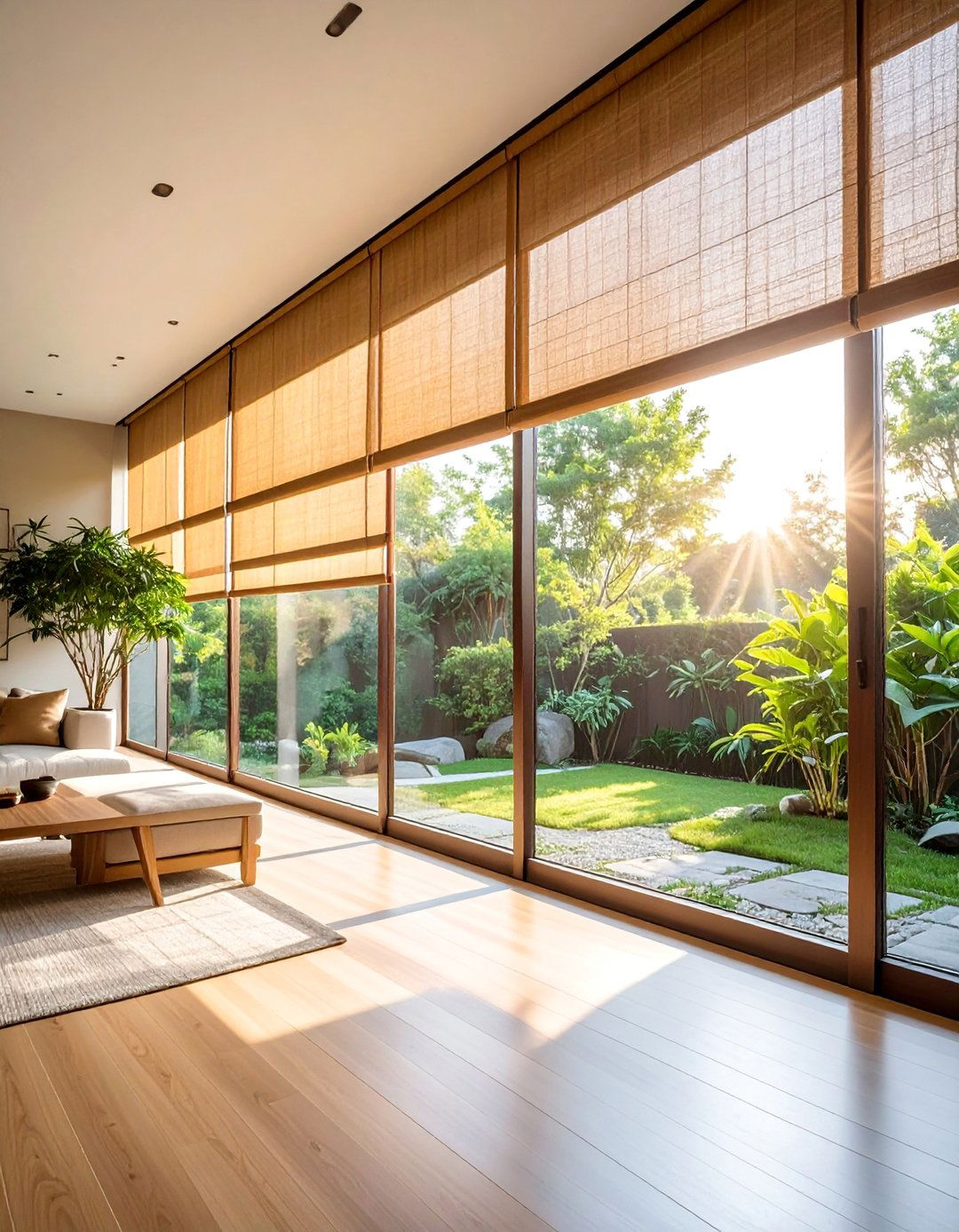
For a window treatment that is both functional and perfectly aligned with Zen aesthetics, consider bamboo roll-up blinds. These blinds are crafted from a natural, sustainable material and add a wonderful layer of organic texture to the room. They offer a clean, uncluttered look that is far simpler than traditional drapery. When rolled down, they gently filter sunlight, casting a warm, dappled light that creates a peaceful and inviting atmosphere. When rolled up, they are compact and unobtrusive, allowing for an unobstructed view and maximum natural light. Their simple functionality and natural beauty make them an ideal choice for enhancing a serene living space.
16. Practice the "One In, One Out" Rule
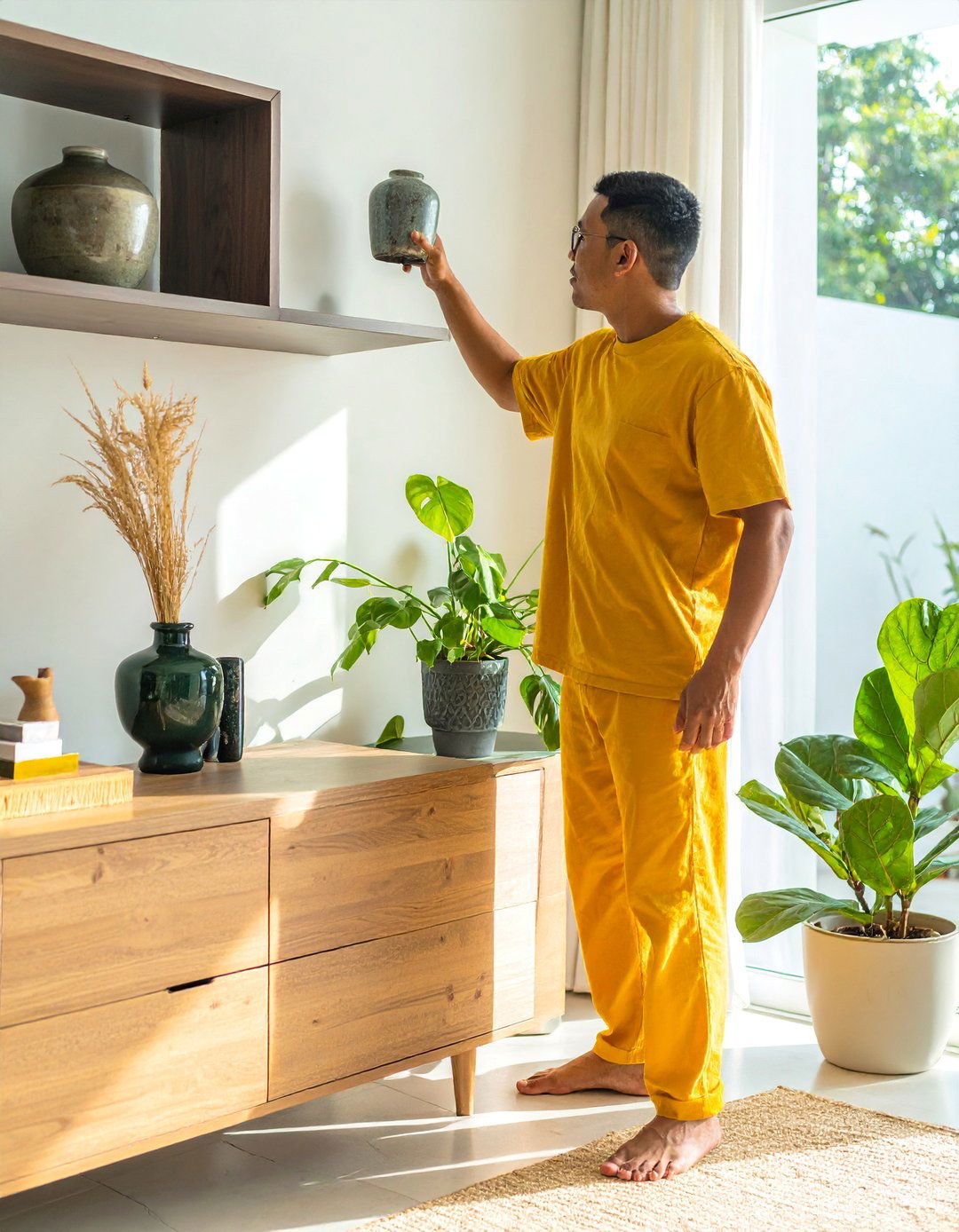
Maintaining the tranquil, uncluttered nature of a Zen living room is an ongoing practice. A simple yet powerful method to prevent clutter from accumulating is the "one in, one out" rule. For every new item you bring into the space—be it a book, a decorative object, or a cushion—you must remove one existing item. This mindful approach to consumption forces you to constantly evaluate what is truly necessary and beautiful, ensuring that your living room remains a curated space of intention. It helps maintain the physical and visual balance you’ve worked to create, preserving its function as a peaceful and harmonious retreat.
17. Use Mirrors to Enhance Light and Space
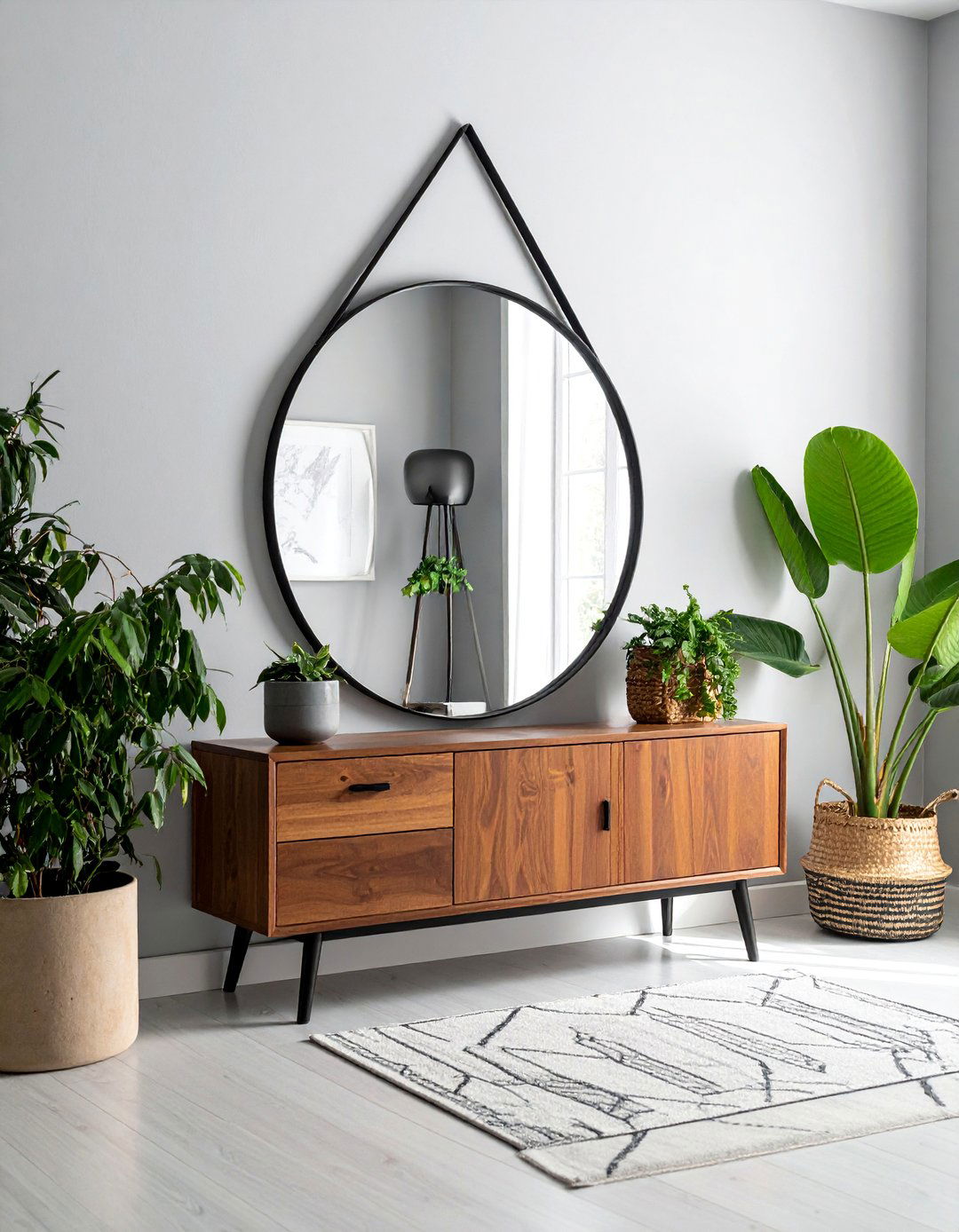
Mirrors are a strategic tool for amplifying two key elements of Zen design: light and space. A large, well-placed mirror can make a room feel significantly bigger, brighter, and more open. Position a mirror on a wall opposite a window to reflect natural light and the view of the outdoors, effectively doubling the brightness and bringing more of the natural world inside. Choose a mirror with a simple, minimal frame made from a natural material like light-colored wood or a thin, dark metal. This ensures the mirror blends seamlessly with the decor, enhancing the sense of spaciousness without becoming a distracting focal point.
18. Integrate a Minimalist Media Console
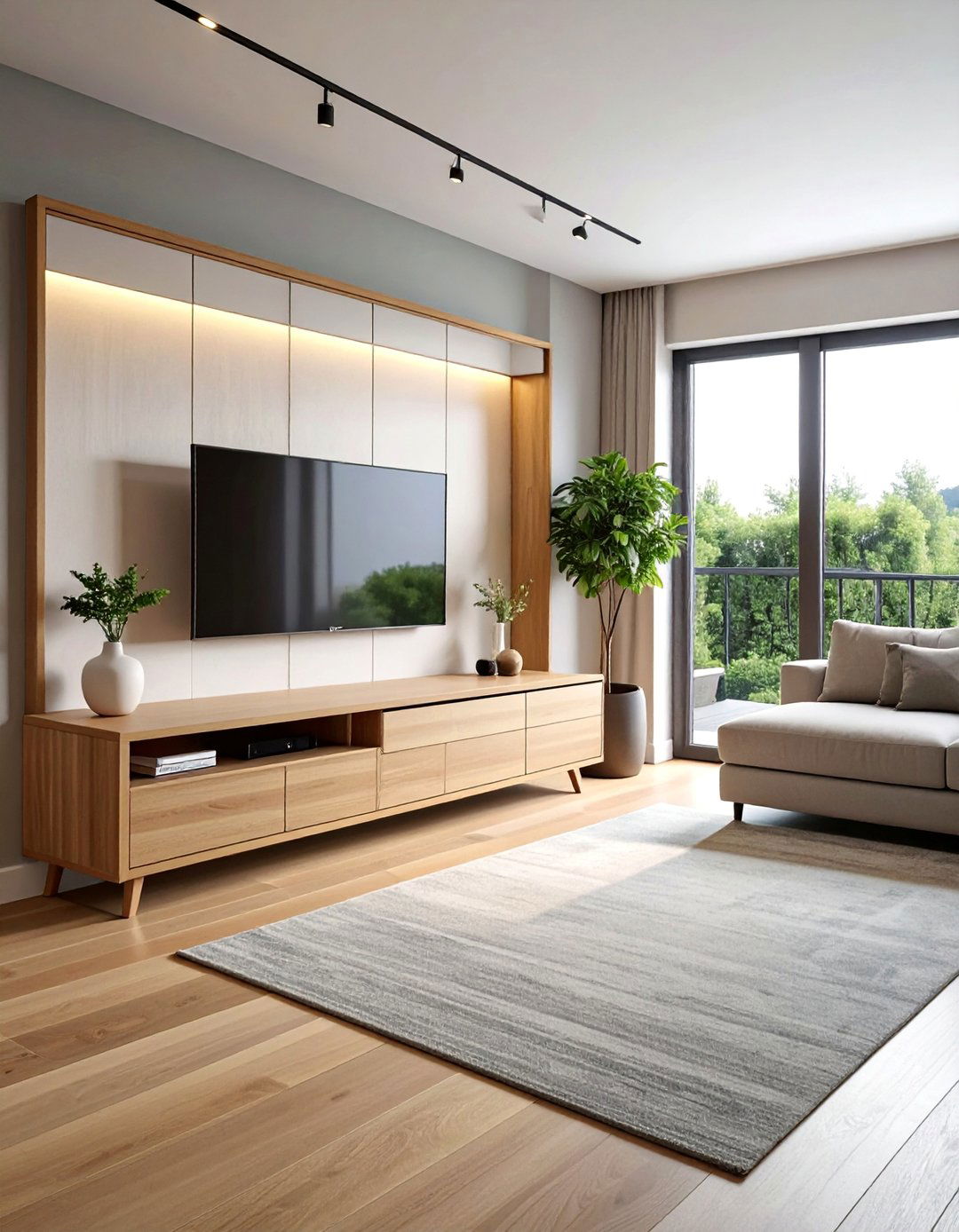
In most modern homes, a television is a living room staple, but it can easily disrupt a Zen atmosphere. To integrate technology harmoniously, choose a minimalist media console. Look for a long, low-profile unit with clean lines and concealed storage. A console with sliding doors or handleless push-to-open cabinets is ideal for hiding away electronics, cables, and other media-related clutter. Select a console made from a natural wood that matches other furniture in the room to create a cohesive look. By keeping your entertainment system neat and contained, you can ensure that technology doesn't detract from the room's overall sense of peace and tranquility.
19. Introduce Aromatherapy with Essential Oil Diffusers
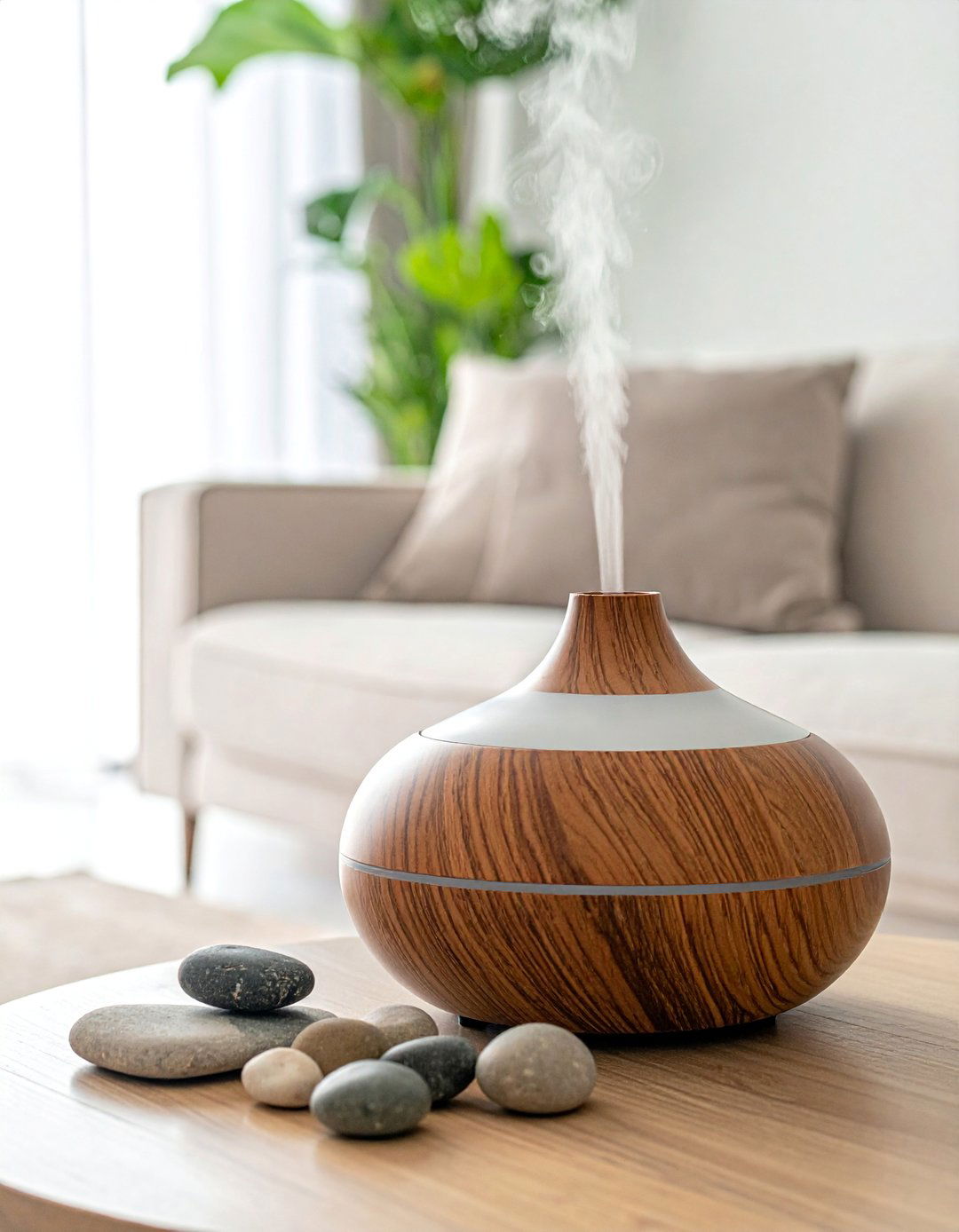
Engaging all the senses is key to creating a fully immersive Zen experience. Aromatherapy can have a profound impact on your mood and the overall ambiance of a room. Place a minimalist essential oil diffuser in your living room to gently disperse calming scents. Choose a diffuser made from natural materials like ceramic, wood, or stone. Scents like lavender, sandalwood, chamomile, and frankincense are particularly known for their relaxing and grounding properties. The subtle fragrance, combined with the quiet hum and gentle mist of the diffuser, adds another layer of sensory calm, making your living room a true haven for relaxation.
20. Embrace Negative Space in Your Layout
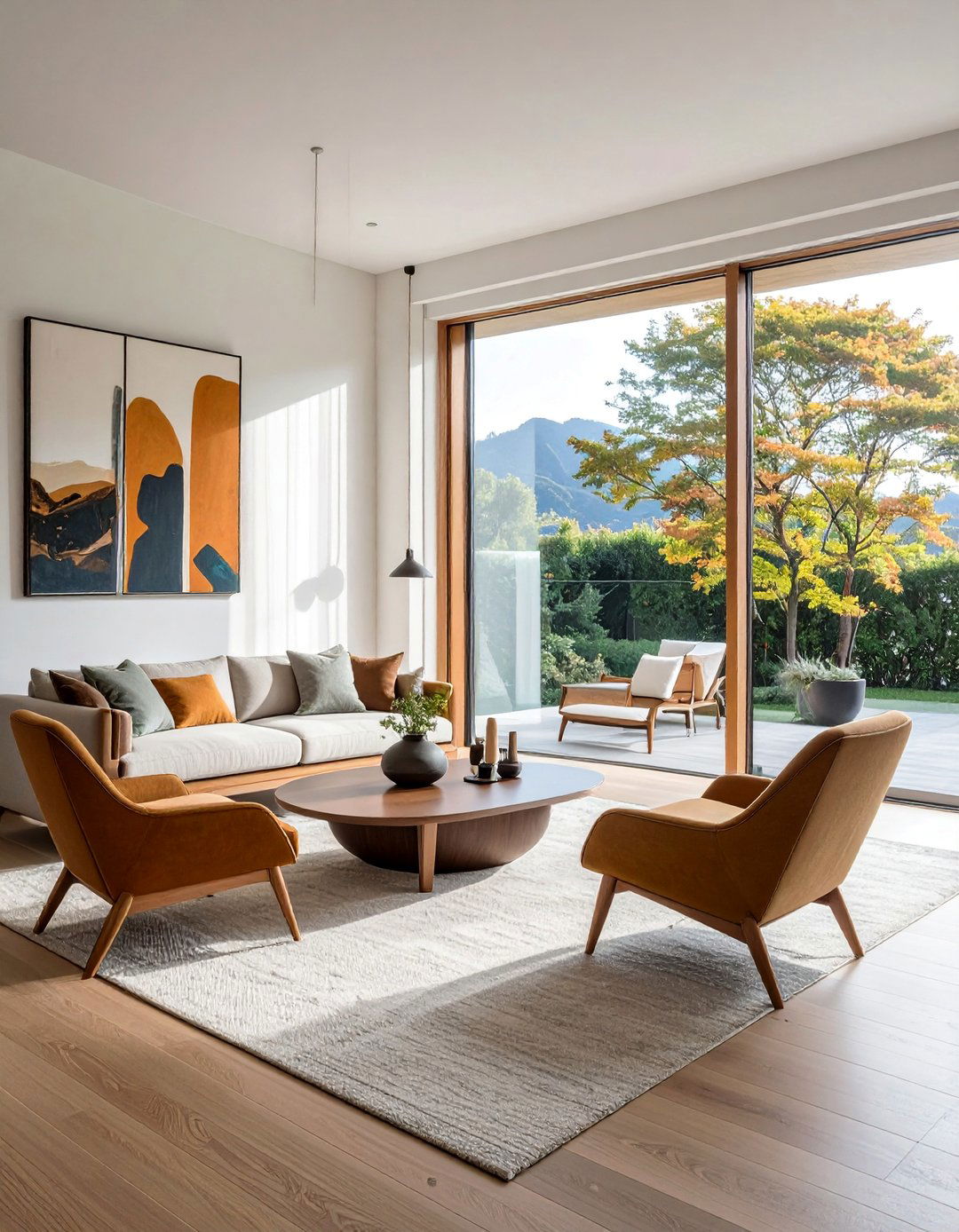
In Zen-inspired design, the empty space—often referred to as "ma" in Japanese culture—is just as important as the objects within it. This negative space gives elements room to breathe and allows the eye to rest, which is essential for creating a calm and uncluttered feeling. When arranging your furniture, resist the urge to fill every corner and cover every wall. Leave ample space between pieces to create clear pathways and an open, airy flow. This intentional use of emptiness highlights the beauty of the items you have chosen to include and contributes to a powerful sense of simplicity and tranquility in your living room.
21. Choose Art Inspired by Nature
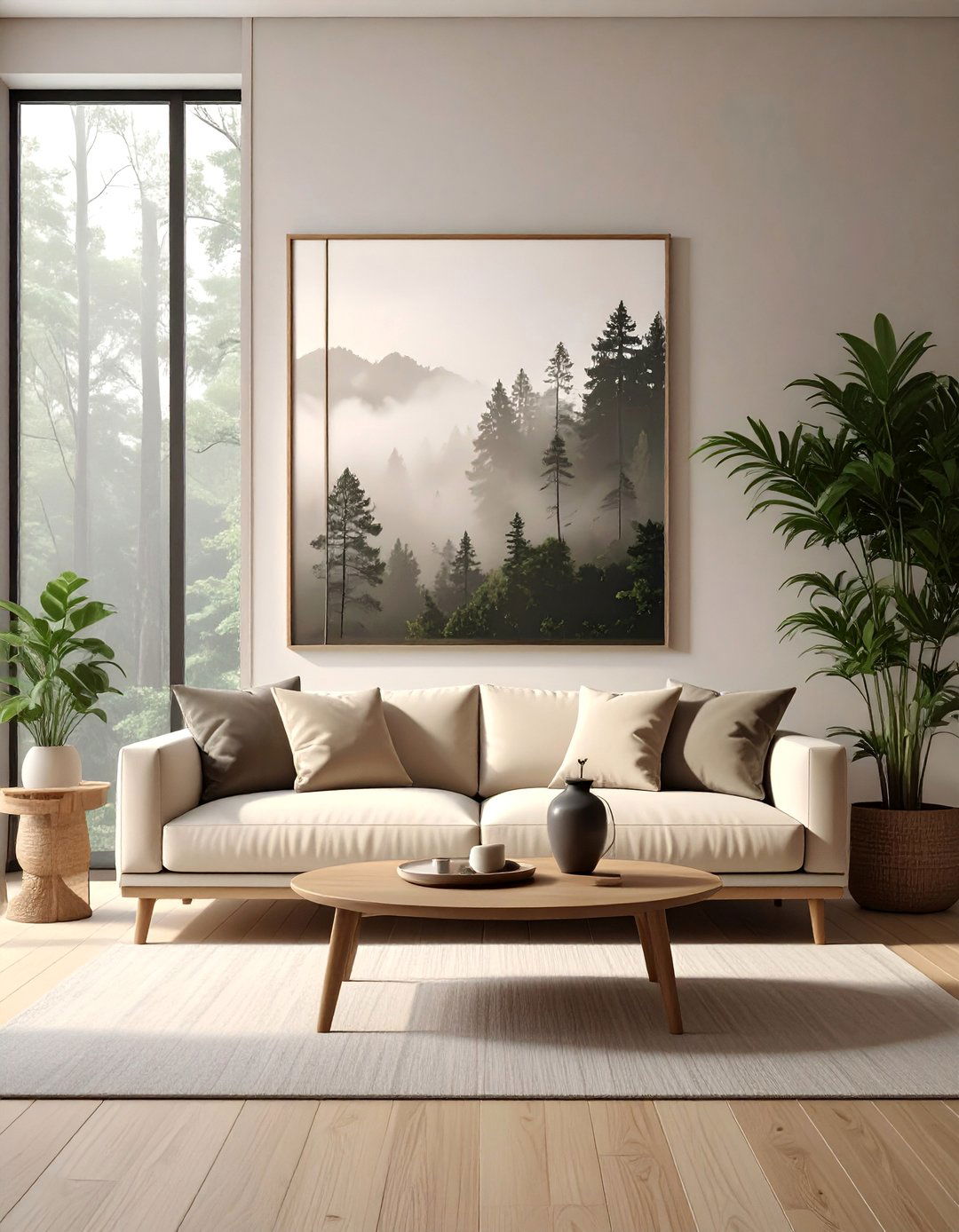
The artwork in a Zen living room should reinforce the connection to the natural world. Select pieces that depict serene, nature-inspired subjects. This could be a painting of a misty mountain range, a photograph of a tranquil forest floor, or a simple line drawing of a botanical subject. Choose art with a soft, muted color palette that complements the room’s earthy tones. The goal is not to create a bold, dramatic statement but to add a subtle layer of beauty that inspires calm and contemplation. A single, thoughtfully chosen piece or a small, curated gallery wall of nature-themed prints can enhance the room's peaceful ambiance.
22. Incorporate Integrated Wood Slat Walls

For a sophisticated architectural element that exudes warmth and texture, consider an integrated wood slat wall. This feature can serve as a stunning focal point behind a sofa or media console. The clean, vertical lines of the slats create a sense of order and rhythm, while the natural wood grain adds an organic, tactile quality. You can choose a light-colored wood like white oak or maple for an airy, Scandinavian feel, or a darker wood like walnut for a richer, more grounded look. This design element adds depth and interest to the room without introducing clutter, perfectly aligning with the minimalist principles of Zen design.
23. Opt for Simple, Unadorned Pottery
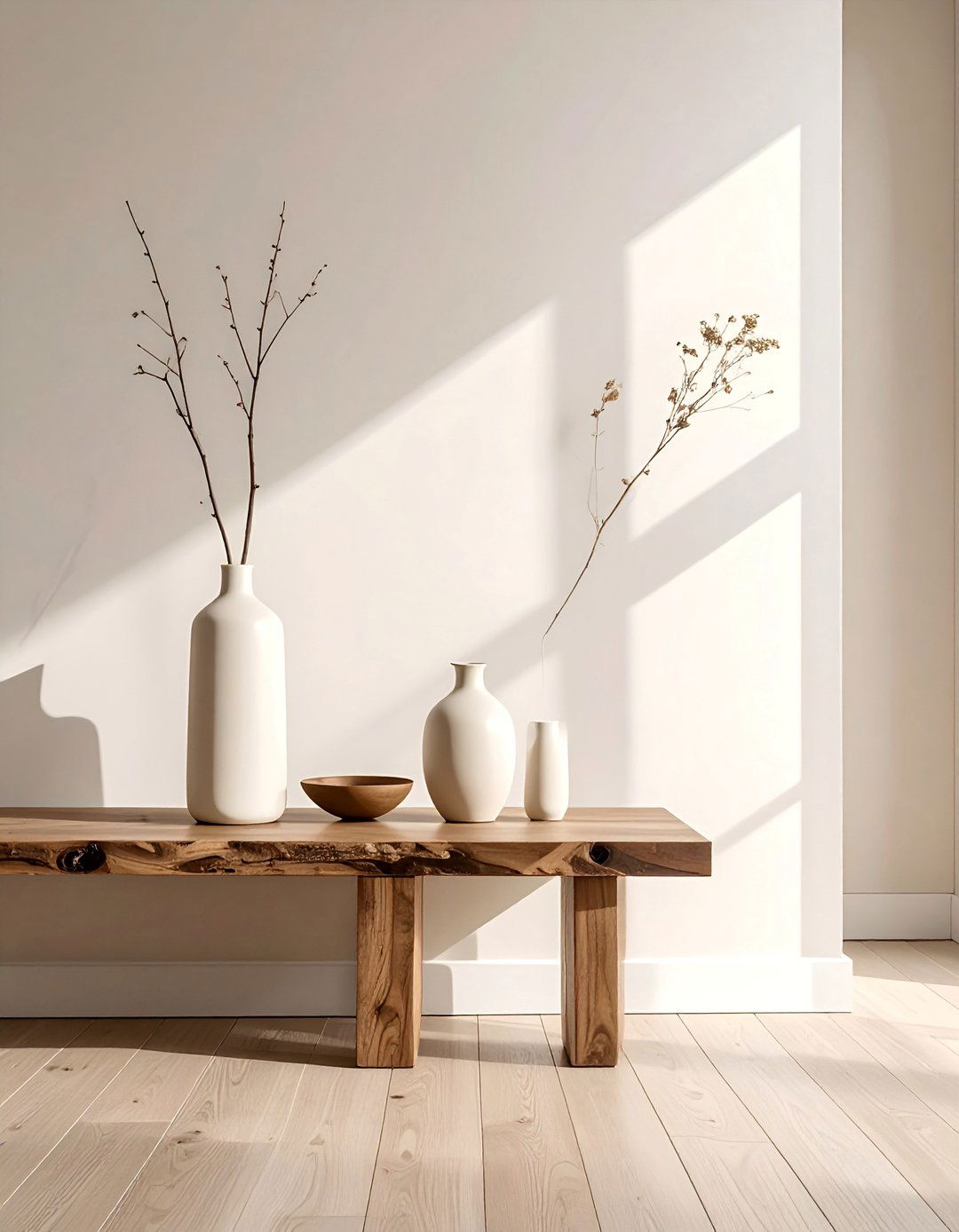
When it comes to decorative accessories, simplicity is key. Use simple, unadorned pottery and ceramics to add a touch of handmade, earthy beauty. Choose pieces with organic shapes and matte, textured finishes in neutral colors like stone gray, terracotta, or off-white. A single large vase holding a simple branch or a few stems of dried grass can be a beautiful and understated focal point on a coffee table or console. A small collection of varied but cohesive ceramic bowls can also add quiet interest. These items celebrate natural materials and craftsmanship, adding a layer of wabi-sabi charm and authenticity to your Zen living room.
24. Create a Dedicated Reading Nook
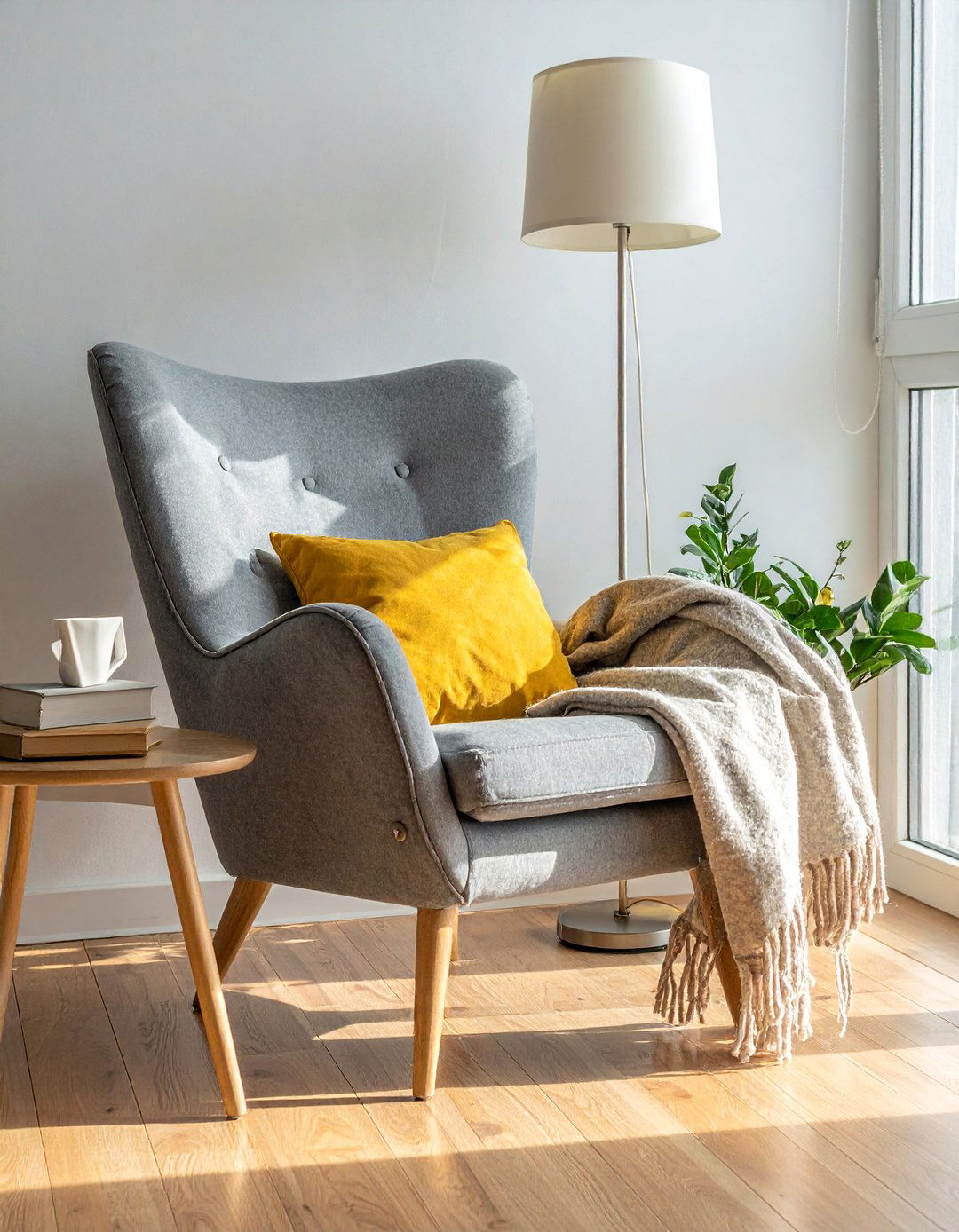
Carving out a small, dedicated space for quiet activities like reading or meditation can greatly enhance the function of your Zen living room. Create a simple reading nook in a quiet corner. All you need is a comfortable, minimalist armchair or a few plush floor cushions, a small side table for a cup of tea, and a soft floor lamp for focused lighting. This designated zone encourages you to slow down and engage in mindful activities, reinforcing the room’s purpose as a sanctuary for relaxation. Keeping the nook simple and free of distractions will make it an inviting retreat within your larger peaceful space.
25. Conceal Cords and Cables

Visible cords and cables are the epitome of visual clutter and can instantly disrupt the serene atmosphere of a Zen living room. Take the time to thoughtfully manage and conceal all wiring from lamps, electronics, and charging devices. Use cord concealers that can be painted to match your wall color, run wires behind furniture, or invest in furniture with built-in cable management systems. Use cable ties or clips to bundle wires together neatly behind your media console. A wireless charging pad can also help reduce visible clutter. Eliminating this "digital clutter" is a small but impactful step toward achieving a truly clean and peaceful environment.
26. Use Books as Mindful Decor

Books can be a source of knowledge and inspiration, but they can also become clutter if not managed well. In a Zen living room, use books as a form of mindful decor. Instead of overflowing bookshelves, be selective. Display only a few meaningful books with aesthetically pleasing covers on your coffee table or a minimalist shelf. Arrange them in a neat, simple stack. You can also turn books around so their pages, rather than their varied spines, are facing out, creating a more uniform and neutral look. This approach treats books as intentional decorative objects rather than just storage, adding a personal and intellectual touch without creating visual chaos.
27. Lay Down a Tatami Mat
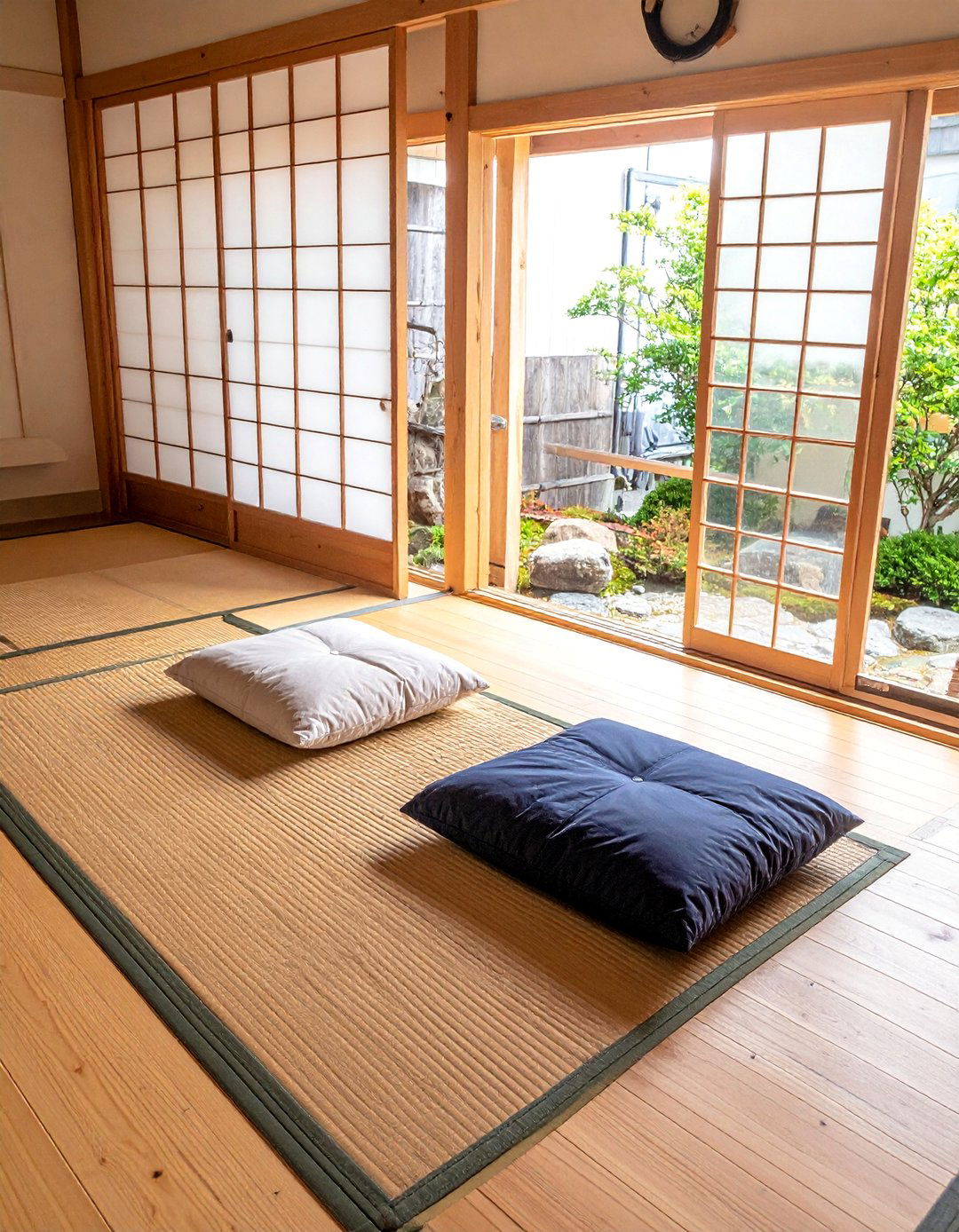
For an authentic and deeply grounding element, consider incorporating a traditional Japanese tatami mat. Made from woven rush grass, tatami mats offer a firm yet comfortable surface and release a faint, pleasant, natural aroma. You can use a single mat to define a small meditation or tea corner, or use multiple mats to cover a larger area of the floor. Their natural texture and simple, geometric form are perfectly in line with Zen principles. They encourage floor-level living, which fosters a sense of being grounded. Combining a tatami mat with low-profile furniture and floor cushions creates a truly immersive and harmonious Zen experience.
28. Choose a Minimalist Fireplace Design

If your living room has a fireplace, it can be a wonderful source of warmth and a natural gathering point. To ensure it aligns with a Zen aesthetic, opt for a minimalist design. A sleek, linear fireplace with a simple surround made of concrete, slate, or stone is an excellent choice. Avoid ornate mantels and cluttered hearths. Keep the area around the fireplace clear and simple, perhaps with a single piece of art above it or a minimalist log holder to one side. This clean approach allows the gentle flicker of the flames to be the main focus, providing a mesmerizing and calming element to your serene living space.
29. Install Sound-Absorbing Elements

A truly peaceful room is quiet. To minimize echo and dampen outside noise, incorporate sound-absorbing elements into your decor. These don't have to be technical acoustic panels. Soft, textured materials are naturally sound-absorbing. A large, plush wool rug, thick linen curtains, and upholstered furniture all help to soften the acoustics of a room. You can also consider a fabric wall hanging or a textured art piece. By reducing ambient noise, you create a more serene and insulated environment where it’s easier to relax, focus, and feel at peace, making your living room a true sanctuary from the noisy outside world.
30. Maintain a Connection to the Outdoors
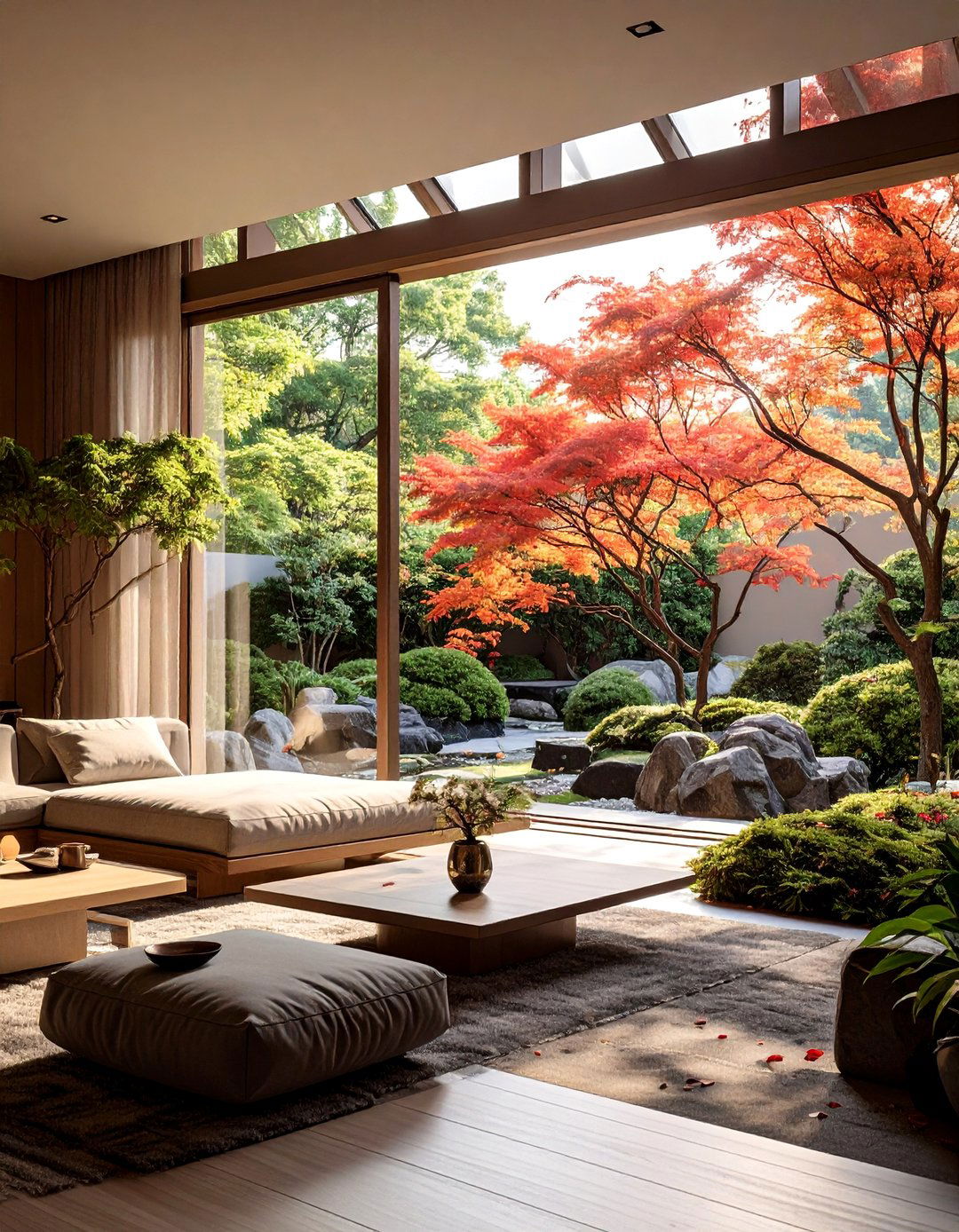
Finally, a core tenet of Zen design is the seamless connection between the indoor and outdoor spaces. If your living room has a view of a garden, patio, or even just the sky, make that view a central feature. Arrange your furniture to face the window or glass door. Keep the view as unobstructed as possible with minimal window treatments. If you have a patio or balcony, use similar materials and colors in both the indoor and outdoor spaces to create a sense of flow. This visual connection to nature is constantly refreshing and serves as a living piece of art that changes with the seasons.
Conclusion:
Transforming your living room into a Zen-inspired sanctuary is a journey of mindful choices. By embracing principles of minimalism, natural materials, and a clutter-free environment, you create more than just a beautiful space. You cultivate an atmosphere that promotes peace, balance, and well-being. Focusing on a neutral palette, maximizing natural light, and incorporating elements that connect you to the outdoors are key steps. Ultimately, a Zen living room serves as a personal retreat, a place to decompress, recenter, and find tranquility in the simplicity of thoughtful, intentional design.


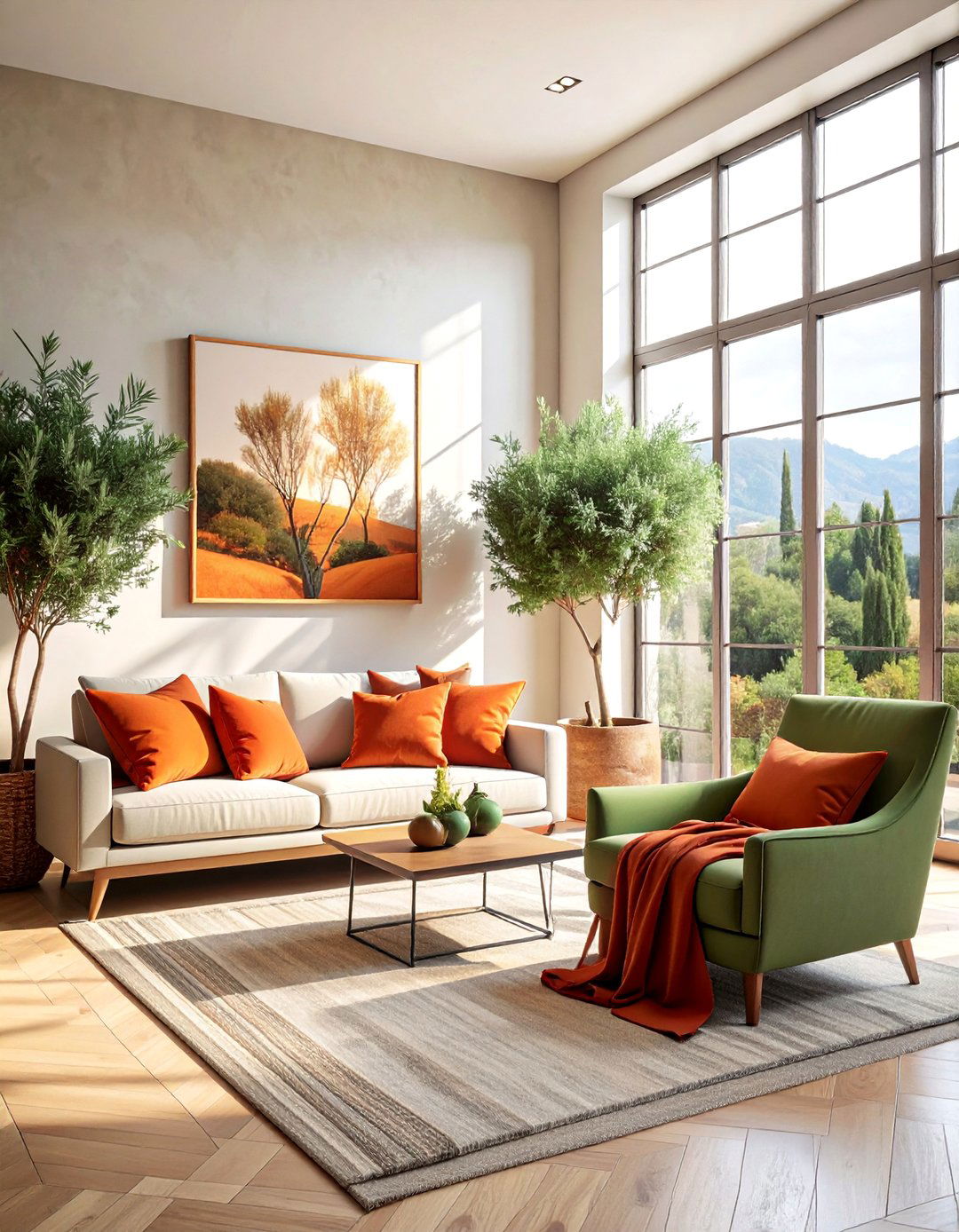
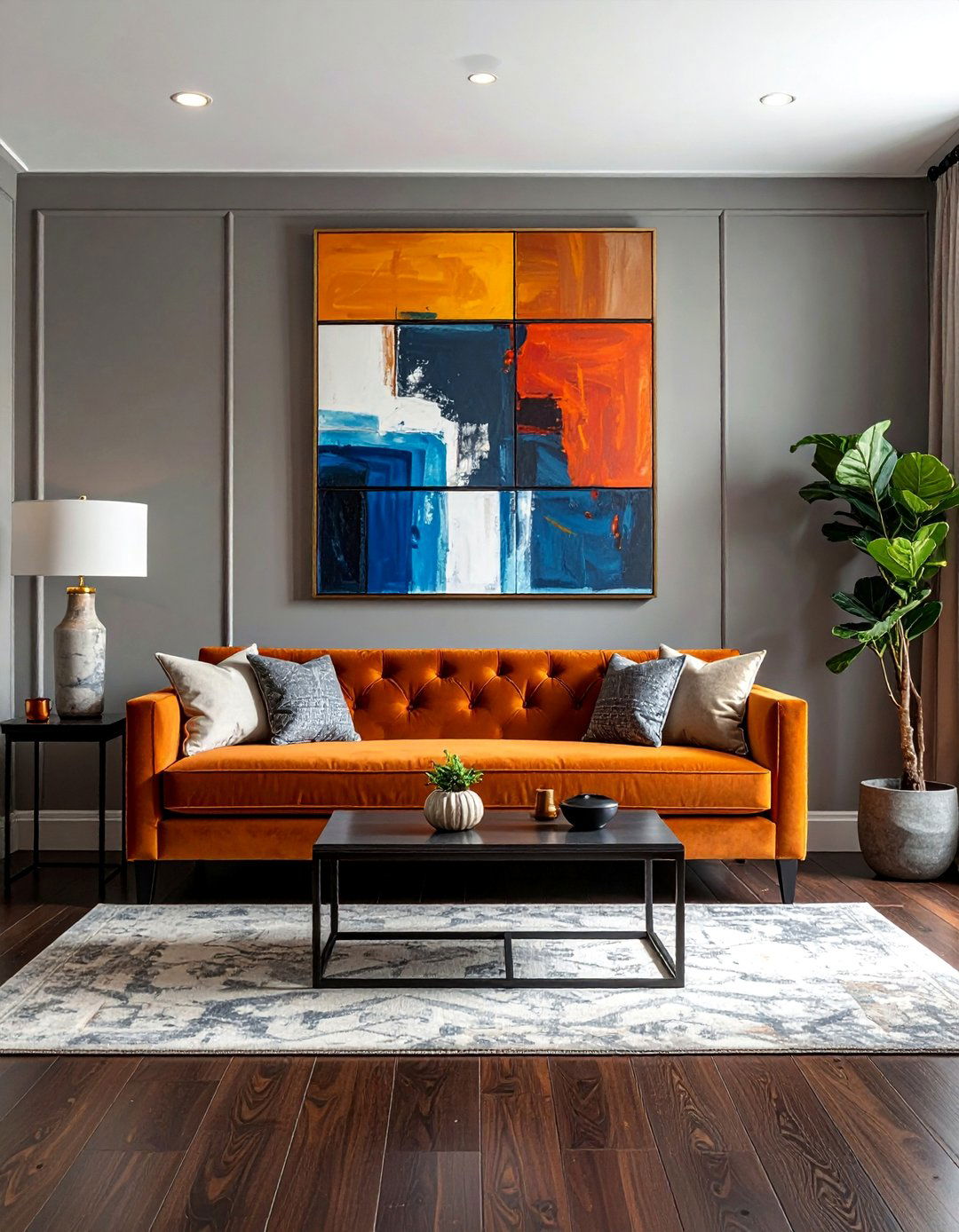


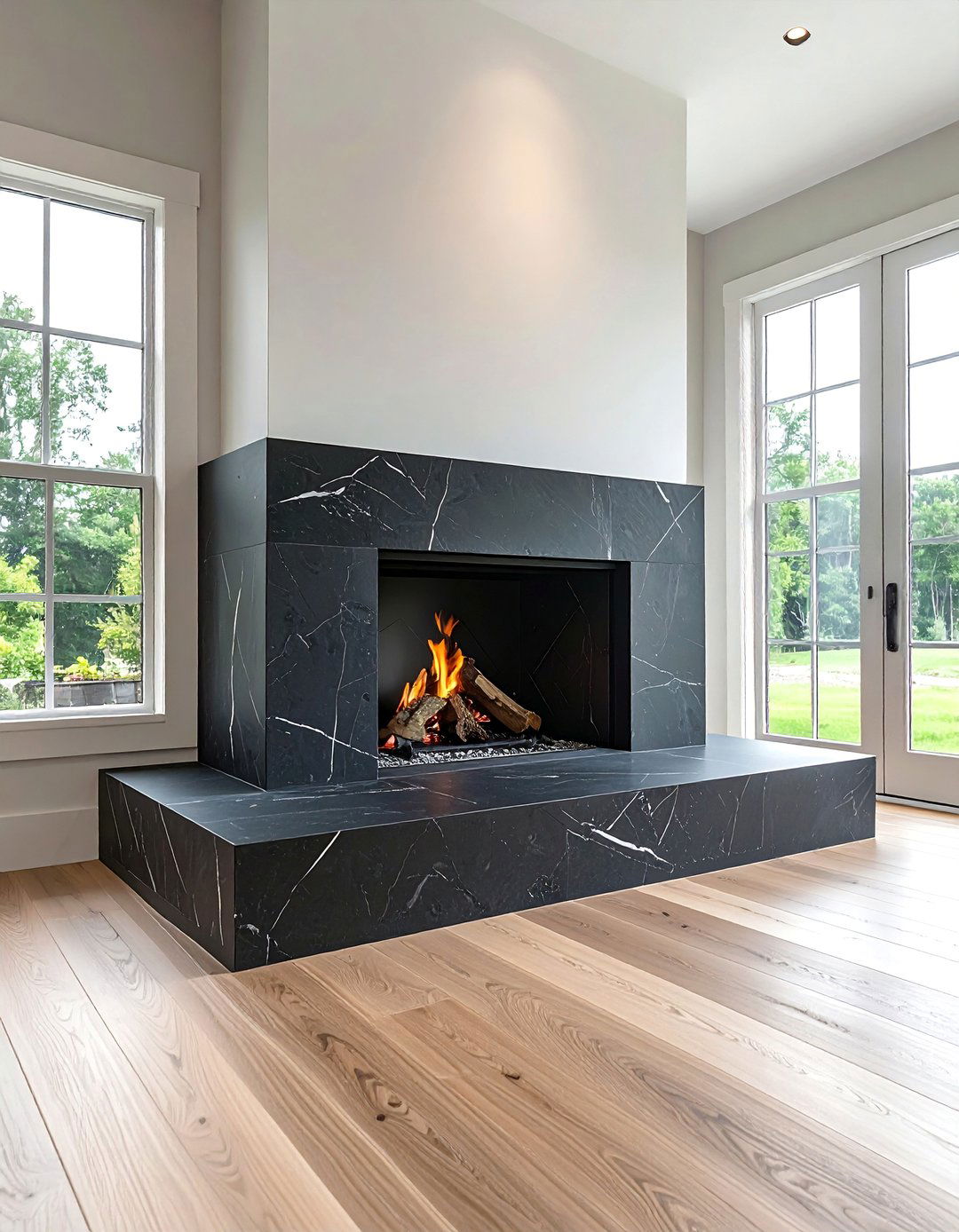


Leave a Reply